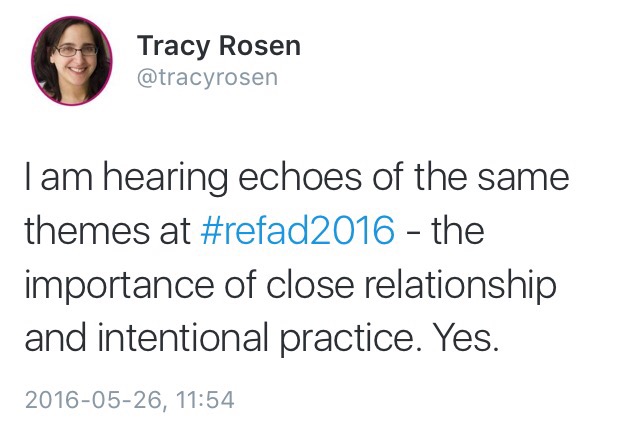Learning at a Distance (or up close!): thoughts inspired by #REFAD2016

 I am in Ottawa at the annual conference on distance education offered by REFAD. One of the opening comments was that distance education is just one of the tools we have to reach our learners and to help frame their learning. I like that the conference started off in this vein. It flows well with my own beliefs in tools – that they are just tools in service of our real work: student learning.
I am in Ottawa at the annual conference on distance education offered by REFAD. One of the opening comments was that distance education is just one of the tools we have to reach our learners and to help frame their learning. I like that the conference started off in this vein. It flows well with my own beliefs in tools – that they are just tools in service of our real work: student learning.
The task then is how best to design learning situations that take place at a distance (or up close!) to reach the needs of our learners in ways that make sense.
The answer seems to lie in relationship and intention.
These are the same themes Avi and I explored with online tutors in adult education a few weeks ago.
CORAL (Complementary Online Resources for Adult Learners) is an online tutoring service offered to adult learners from LEARN Quebec. CORAL’s Barbara and Cheryl asked us to accompany their tutors in some professional development on tutoring at a distance.
At REFAD, presenters from CEGEP á Distance (CAD) told us their story of online tutoring. They talked about the centrality of feedback for success and for fighting dropout rates and absenteeism in distance learning.
What I found especially interesting is that their tutors are all CEGEP teachers, which is a similar situation as our CORAL tutors who are all teachers within Quebec’s English sector Adult Ed system. What the CAD is doing, is providing their tutors with explicit professional development in how to provide effective, intentional feedback as the backbone of their practice.
Roselyne Boyer from Université de Laval spoke about the biggest task in online learning being to manage the human element within all of the technology and in face of the distance. That is, in fact, her vision, as shown in this image from her presentation.
It is really from this point that Avi and I framed our Professional Development with the tutors at CORAL. Our main message was that no matter where we are teaching, the student-teacher relationship frames the work.
Rather than focusing on the technology behind online learning, if we focus on student learning we can then find the tools that make the most sense for everyone within that context.
To return to what I wrote earlier – while the teacher student relationship frames the work, there is also that other human factor that is often missing from the context of the work: the social context.
P., a high school student from Ontario took both online and face to face courses at his school and he shared his experiences with us at REFAD2016. While he did well in his online courses, he preferred his face to face courses because of his friends in the room. I have a feeling that a perfect online course (if that can possibly exist…) will exist somewhere in between the online and the face to face.
So. Flexibility, differentiation, and a recognition of the human element (it is sacred) need to be key factors of learning at a distance. Not very different from learning in presence, is it?
**Featured image: Don’t waste your time or money on ROT! Wellcome Library, London, on Flickr. Shared via CC. BY. ND. NC
2 Replies to “Learning at a Distance (or up close!): thoughts inspired by #REFAD2016”
Comments are closed.



Very interesting and not in the least bit surprising! Thanks for sharing!
Hi Susie – nice to see you here and thanks for commenting. Yes! Lately I find that I am always being reminded about how important purpose and relationship are to learning – no matter where that learning takes place! It is a good place to start, in any case. That way, if I am unsure about how best to teach a group I can always ask myself – ‘What is our purpose, how can I make this make sense for me and my learners?’ – and that will be a good start.